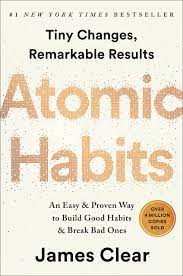Title: Atomic Habits
Author: James Clear
Reviewer: Kamal Aakarsh Vishnubhotla
The author — James Clear — presents in this book, very compelling arguments and examples from his in-depth research spanning multiple areas like sports, arts, science, business, history etc., to pick interesting nuggets that serve to push his framework. And his frameworks are very practical, with a good mix of examples and some thought-provoking life philosophies as well. Below are some key take-aways from the book that I picked up:
There are 3 layers to changing habits:
Changing outcomes — results like losing weight, running 5kms etc.
Changing process — developing systems and routines that help people achieve goals.
Changing identity — changing some beliefs which drive actions.
The author makes a convincing argument that people generally start with the goal of changing outcomes, which is why they can’t sustain the habits. The idea is to start with changing identity first — it is not about what people want to achieve but more about what they want to become. Once people focus on identity, he says, they will use behaviors that are likely to act in accordance with that identity. The goal, hence, is not about running 5kms but to become a runner. Once the focus is on changing the identity, the changes in process will fall in place, leading to the change in outcomes anyway.
The author’s framework to the formation of right habits is:
Cues — triggers and signs in environment; you need to make it obvious
Cravings — motivations to pursue; you need to make habits attractive
Response — actions we take; habits need to be made little easy to start with and then little hard incrementally, so that they don’t become too hard in one go. Make it easy does not mean easy things — but to remove as much friction that stands in the way of doing things you want to do.
Rewards — feedback, the satisfaction for cravings; habits need to be made satisfying.
For each of the above elements in the framework, the author provides practical advice on what levers could be changed, to make those elements effective. For example: For cues, the author covers aspects like location, time and also what he calls habit stacking (piling a new habit on top of an existing habit). He also advocates planting visual cues all along the spaces so that the environment is designed right for habit formation. For craving, he suggests ideas like temptation bundling (like get on treadmill while watching Netflix). In the course of these practical tips, the author presents quite a few thought provoking arguments, which you might nod a yes to. In a chapter, he says that every behavior has a surface level craving and a deeper underlying motive — survival, conserving energy, social acceptance, reproduction, etc. Many products are developed with an aim to meet such innate cravings (For example: Instagram — win social acceptance). Habits are modern day solutions to ancient desires, new versions of old vices. And while digging deep into these aspects, he also busts several myths around habit formation, like this: To master a habit, the key is repetition, not perfection.
What makes this book interesting are these specific observations and analysis from some of the examples from history, arts etc. The book places lots of importance on the “how” of developing habits, giving some guidance on even how to formulate the goals (or rather systems). In fact, the author debunks the idea of goals but focuses more on systems. And the guidance is also on how aggressive or realistic the habits need to be. He says that our brain loves challenges, but only when the challenges are within the optimal zone of difficulty, a bit on the edge. A challenge that appears to be within some reasonable reach if you put in the effort. And such little improvements and challenges can keep you engaged — achieving a flow state.
While formation of habits forms a large part of this book, the author also dwells on sustaining a habit. He says — “the greatest threat to success is not failure but boredom. We tend to give up habits because they fail to delight us, after we form a routine. We desire novelty — bad habits are addictive because they constantly provide novelty. So we need to create variable rewards, so that there is a spike of dopamine and accelerates habit formation. The only way to become great is to fall in love with the habits everyday and learn to be endlessly fascinated by the same thing.


